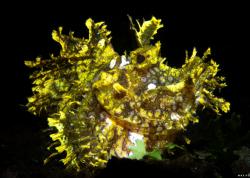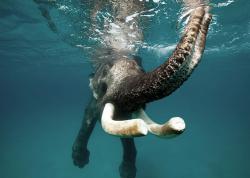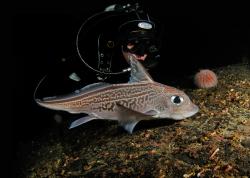Blue Whales in Sri Lanka with Theresa Guise and Peter de Maagt
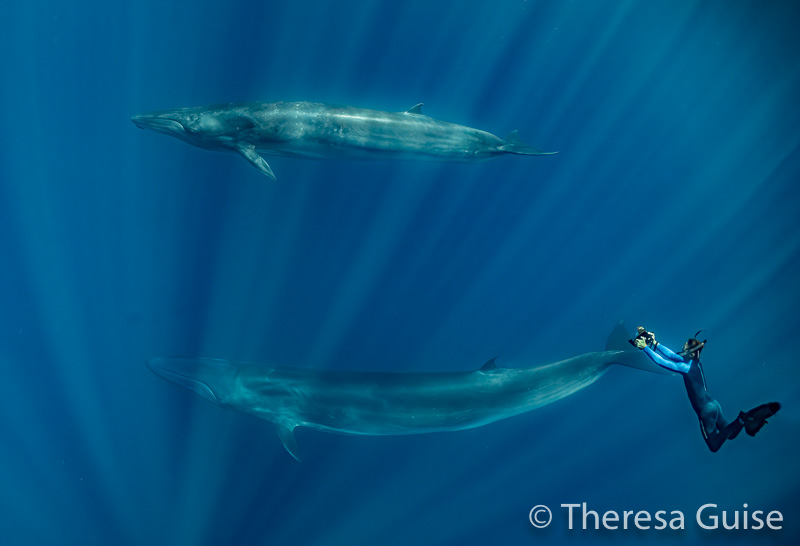
As a member of the Bristol Underwater Photography Group in the UK, I was fortunate to attend a call with Theresa Guise, and Peter de Maagt and listen to their far flung adventures with cetaceans in Sri Lanka, and some unexpected encounters with marine litter.
One of unexpected advantages of relying on online collaboration tools is that it gives us the opportunity to engage with speakers from various parts of the globe. Theresa joined from the US, and Peter from the Netherlands. This is certainly a positive spin on the restrictions imposed by lockdown.
One of my dreams still un-fulfilled is to dive with whales. The enthusiasm for being in the water with big animals certainly came across in their talk. Peter waxed lyrical throughout on the talk on how amazing it was to be in the water with these behemoths.
The trip that Theresa and Peter went on was an area off the coast of Sri Lanka. The area benefits from a deep canyon, which seems to be a favourite spot for large marine mammals. The line-up of whales that they saw in the water was quite spectacular and included: Pygmy Blues, Brydes, False Killers, Sperm, & Pilot whales. Along with unexpected encounters with Orcas, and Whale sharks. Interestingly one of the Orcas was identified and had been seen in another area of Sri Lanka before, and is potentially a year round resident. I always thought Orcas were partial to cold water. Apparently most visitors don’t have such great luck with the amount of encounters they had on this trip.
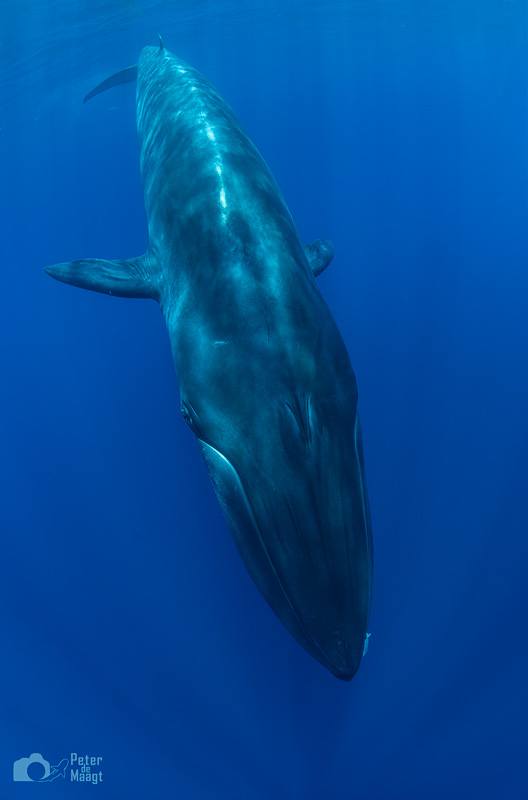
While searching for whales the team came across discarded ghost nets floating on the surface entangled with other debris. After closer inspection they realised that a turtle was trapped in the debris, and slowly drowning. Alex Mustard was on the trip, he jumped in the water and was holding the turtle up (see image below) so it could breathe while they disentangled it. Luckily on this occasion they managed to free the turtle which after a few moments of thrashing around managed to swim away safely. They encountered the same circumstance the following day, and saved another animal.
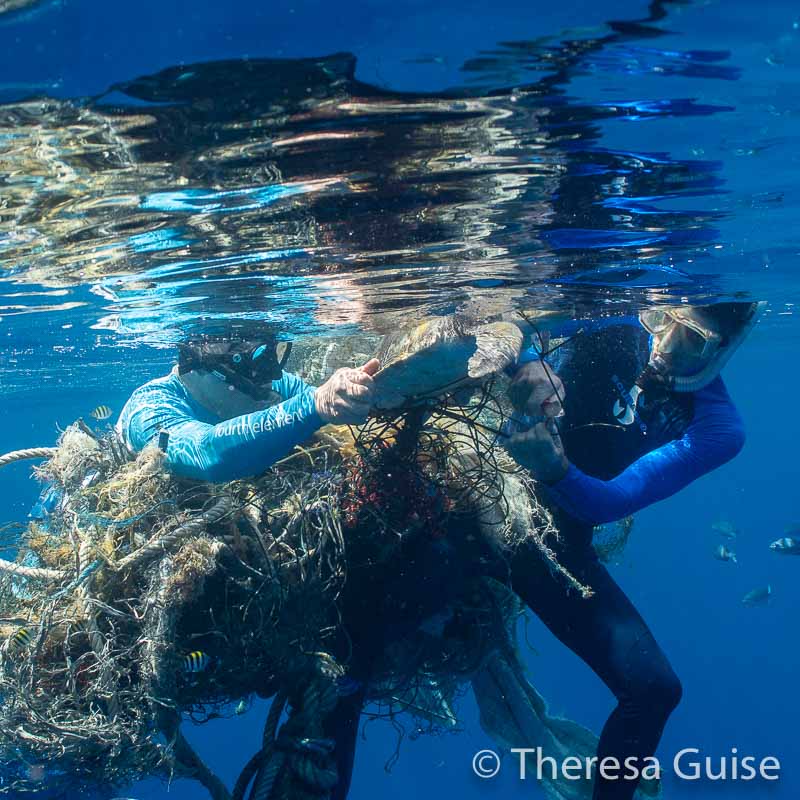
An image showing the remains of a carapace in a net demonstrated this is likely going on all the time with many animals not surviving. So sad. Peter talked about using satellite data to try and narrow down the source of where all the rubbish comes from and how it ends up in the ocean, but this was currently inconclusive and more work is needed.
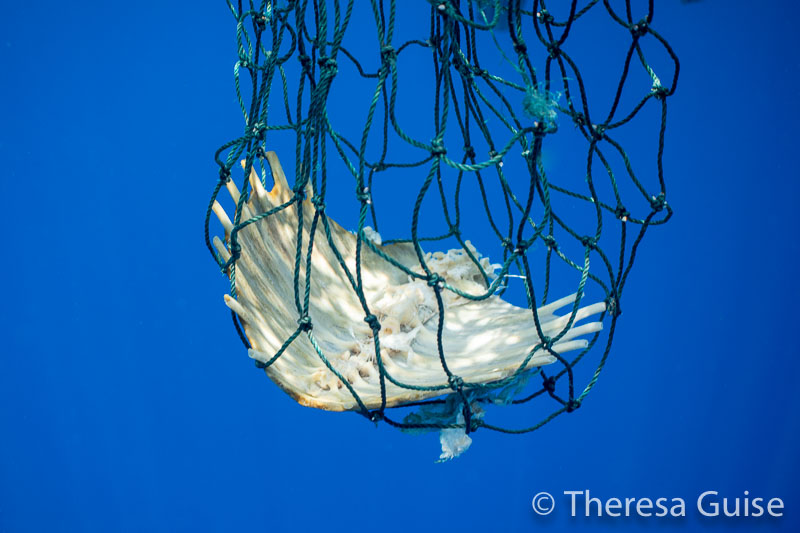
Robert Bailey: After listening to your presentation at the Bristol Underwater Photography Group (BUPG). I thought it a good idea to interview you two from both a big animal adventure angle, and from a conservation perspective. How did you get into underwater photography, and what's been your evolution as photographers?
Theresa Guise: I did some photography when I was in college. I used film and developed my own images. When I got busy with medical school, I just didn't have time for photography until I started diving about 15 years ago. Then, I revisited photography and bought a point-and-shoot to document my underwater experience. My interest in underwater photography grew, and I signed up for a trip with Alex Mustard about 10 years ago to the Red Sea. I learned so much then and continue to learn. Photography helps me stay creative as well as to compliment to my real job in which I study cancer and the tumour microenvironment. The ocean is another microenvironment that I like to study; it’s fun for me. I’ve continued to study with Alex and routinely go on his workshops. It’s been a good journey, and that's how I met Peter de Maagt.
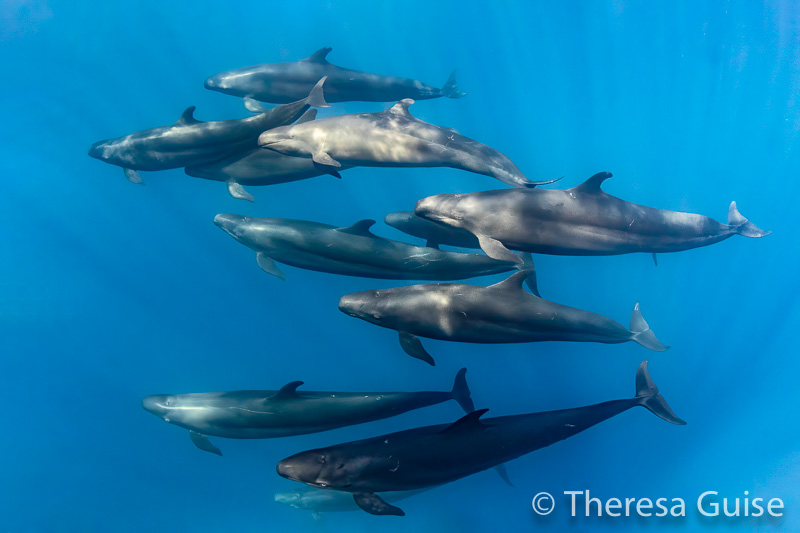
Robert Bailey: Excellent Theresa! Peter? What about yourself?
Peter de Maagt: I was diving probably 10 years before I started taking pictures and in all honestly I was getting a bit bored of just diving, I was looking for something additional, and photography was it. I thought an interesting thing to do was start with a point-and-shoot small Sony camera, and I enjoyed it a lot. I honestly felt like Jacques Cousteau! It was phenomenal! Then I was like, okay, I wanted to try a bit better camera, so I got the Canon G7. I took that camera diving, and all the pictures basically failed and I got frustrated. I just wanted to understand why a simple Sony takes fantastic images and a G7 is giving me rubbish. Then I really started learning about photography and moved to a Nikon D300 system. I improved from that point onwards and accelerated when I started taking courses with Alex Mustard. I now use a Nikon D500 for macro, and a Nikon D850 for wide angle photography.
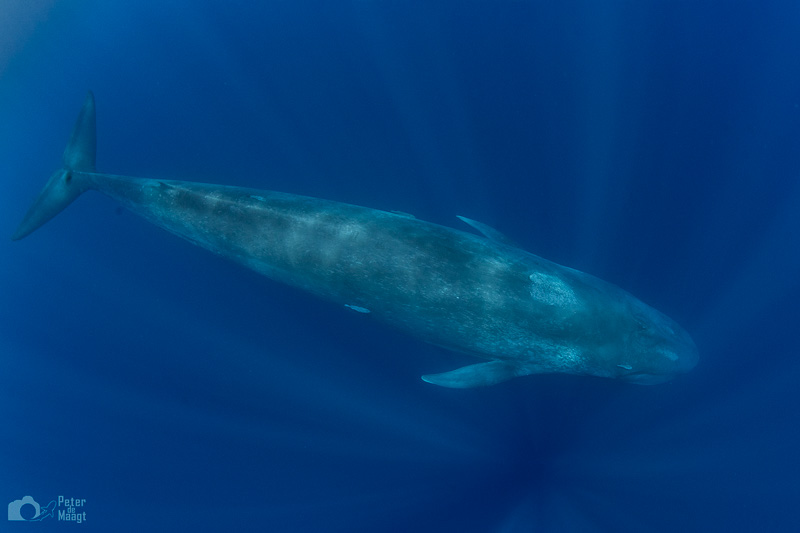
Robert Bailey: Okay. What do you guys do with your images today then? Theresa?
Theresa Guise: I use my images to educate the public on ocean conservation through social media, photo competitions, and articles that I do with Peter. Peter’s the driver for the magazine articles we publish. I donate some images to benefit charities, have done photo exhibit shows as well make calendars which I share with friends. Recently I’ve been commissioned to make prints for friends or others who contact me directly, but I don't have a website other than what’s on Instagram and Facebook. Getting the word out about the ocean and communicating to the public about the importance of conservation is the most important aspect of sharing photography. I use my images on social media with that in mind.
Robert Bailey: And what about yourself Peter?
Peter de Maagt: Like Theresa’s it gives me a super good feeling when my images are used for conservation purposes. I do enter competitions as well. We actually write a number of articles and have done some on the UK, South Africa, Germany, USA, Asia, and the Netherlands too. I think the simple fact that an image is used to aid conservation really gives me so much pleasure. I mean you don't gain anything; it doesn't give you any money. But the sheer satisfaction that it gives you, that it’s being used for something useful, for me, is worth a lot. That's it. I mean that's all the reward that I need from my underwater photography.
Robert Bailey: Okay fabulous. Yeah. I understand the cause for conservation very well indeed. So what do you guys do you for a living? I've seen your job titles in emails. Would you mind elaborating?
Theresa Guise: I'm an endocrinologist and a physician and a scientist. In the clinic, I address bone health in patients that have cancer. I have a research lab where we study mechanisms and develop therapies for bone cancer. In the laboratory, I study how cancer and its treatment affects the musculoskeletal system as well as metabolism.
Robert Bailey: Very interesting Theresa. Peter, you work for the European Space Agency (ESA) correct?
Peter de Maagt: Yes I'm an antenna specialist
Robert Bailey: Can you just expand on that a little bit?
Peter de Maagt: Much of the technology involved in taking underwater pictures, and photography in general is similar in my daily job. Working with optical designs is what I do as a living, except I do it with microwave frequencies. The techniques and the theory behind it are the same as photographic technology. Basically we design antennas for spacecraft. For the terrestrial ground segment we design scientific antennas. Some of these scientific antennas can be used to study the earth or the universe, like cosmic microwave background. There are a lot commonalties with all the technology that we use, and the fundamentals of photography.
Robert Bailey: Very interesting. So when you say you're studying microwave background, is that evolution of the universe, the big bang, and trying determine the age of the universe, those sorts of things?
Peter de Maagt: Yeah. That's one example. Yes, indeed.
Robert Bailey: So what were your expectations, and is it fair to say your expectations for the trip were met?
Theresa Guise: The experience far exceeded my expectations. I would have been happy just to see blue whales from the surface, without ever being in the water. Alex actually said we should have low expectations because the encounter experience is highly variable. I think we hit the jackpot on our trip; we were extremely luck. I was expecting to see blue whales, which we did; but we also swam with them and photographed them. In the end we saw 13 different types of cetaceans including orcas! We encountered orcas on the last day, which was icing on the cake!! It was the most physically demanding trip that I've ever been on. It's challenging because you have to free dive off a speeding boat multiple times a day and experience numerous bumps and bruises. You are exposed to the equatorial sun, with very little sun protection on the boat. It was not a luxury boat; no creature comforts. But it was well worth it, and I would do it again in a heartbeat!
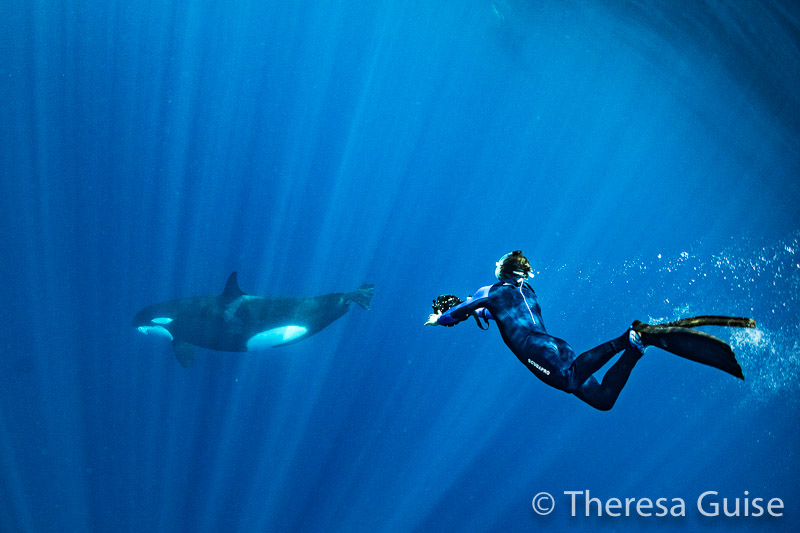
Robert Bailey: Peter?
Peter de Maagt: It’s going to be super easy interview for me because I'm just going to say I entirely agree with Theresa … Yeah thinking about it now I actually had zero expectations.
Robert Bailey: I guess the disturbing conservation images showing turtles entangled in floating debris and near drowning was just a chance encounter when you were looking for whales?
Theresa Guise: I certainly didn't expect anything like that, seeing turtles caught up in ghost nets! We found three in total. Two caught up in the nets which we worked to free, and a dead one … It was an eye-opener! I did not expect to see so much trash in the ocean or to witness the turtle entrapment.
Peter de Maagt: Yeah. I agree. We started taking pictures of marine litter from that point. We were out there for whales, but after a while we started looking with a greater sense of purpose to see if we could find more turtles. Our guide and naturalist on board was also interested in aiding our cause.
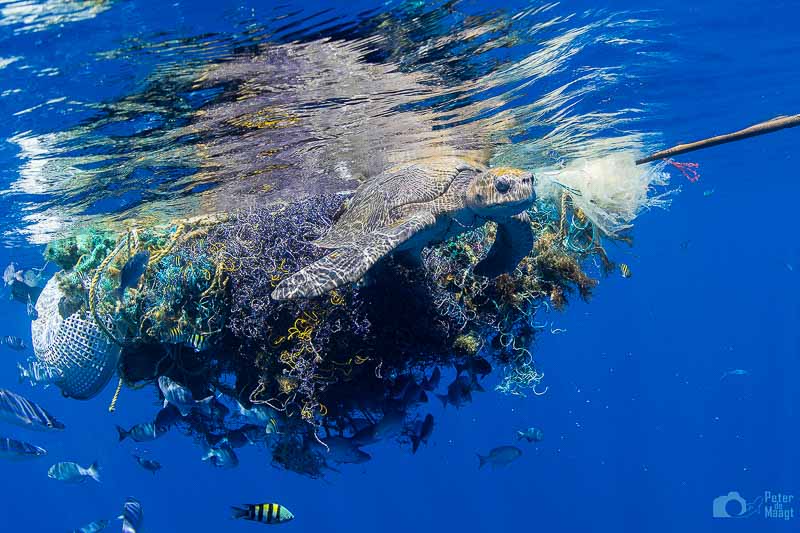
Theresa Guise: We started to look for them after our first encounter. The first turtle we just happened on after we observed a boat already stopped near the floating pile of debris. They were trying to free a turtle, but they didn't have a knife. Peter and Alex got in and used a knife from the lunch box to cut the turtle from the net. That was a real eye opener. We started to realize that there was debris all around, and kept a watch out for more nets from that point forward.
Robert Bailey: Is it just an operator driving the boat, or was there a deckhand on there to help you get in and out of the boat? That's the first part of my question…
Theresa Guise: There's a naturalist who is at the front of the boat and then the driver and two to three photographers, and you. You're out on the water for six hours at a time looking around looking for whales The hard part is free diving off the speeding boat. You dive in with your camera, head first, after bumping and slamming your body every which way. When you dive in the water you crash into each other. I don't know how many times you dive off the boat each day, but it’s a lot. There is a ladder on the boat, making it easy to get back on board. There's only a very little cushion on the seats and you're bouncing up and down all day on the boat. You definitely end up using a lot of energy doing the free diving and getting beaten up.
Robert Bailey: Circling back to the second part of my question about the people on the boat. What was their reaction to all the litter in the water. I mean did you feel that they were they concerned about it? How did you guys interpret their feeling about what you were doing to free the turtles
Theresa Guise: The naturalist on board was very upset to see the turtle. The first turtle we freed was an Olive Ridley, a species under threat. He was very enthusiastic about helping us, and he was actually the driving force for finding the other ones.
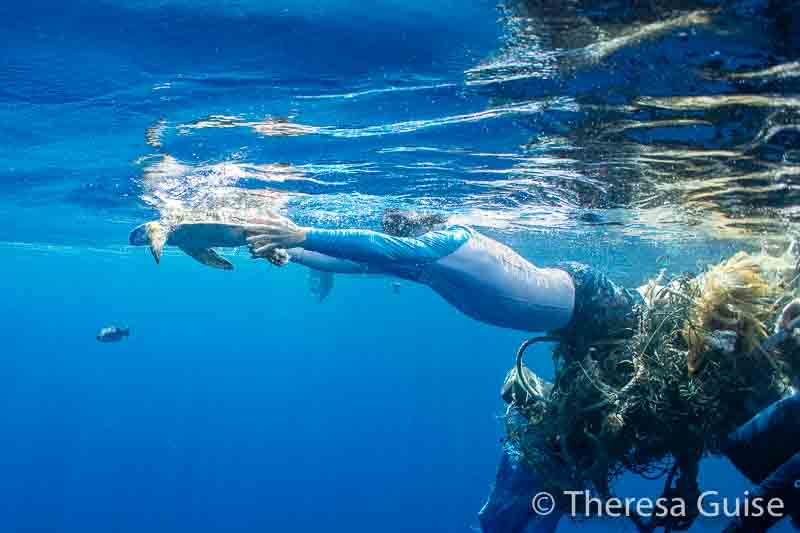
Robert Bailey: That's great to hear for sure.
Theresa Guise: The second turtle was a green turtle, and much more common than the Olive Ridley. We also found a turtle skeleton in one of the ghost nets, which was really sad.
Theresa Guise: The naturalist as I mentioned was as interested as we were to search through the marine litter. In the end we actually spent a lot of time free diving where we found litter. The naturalist got in the water with us and was pointing things out to us. I think he had more fun doing that then riding around in the boat looking for whales. Aside from the turtles in peril we did end up finding an area where clear signs of dynamite fishing had taken place, and that was pretty disgusting.
Robert Bailey: Do you have anything to add to what Teresa was saying?
Peter de Maagt: I think if I look back at when we were cruising through the area where there was evidence of dynamite fishing it was something the boat crew see on a regular basis. It was not something shocking that they hadn't seen before. The crew were definitely not happy about it, but I think they know that it's part of life in Sri Lanka.
Robert Bailey: It's an interesting thing experiencing dynamite fishing. I was diving in Borneo when I first experienced the shock waves underwater from dynamite being set off in the area. You hear and feel them intensely. It's terrifying to be honest. I'd never witnessed anything like that before. When I resurfaced the guide looked at me and he said, ‘Hey, ‘they're starving over there’. I didn't feel much sympathy at that present moment. I thought how short-sighted that you think that you can actually survive long term when you’re killing the environment. I was left wondering why the locals didn’t try to make a living off diving tourism. Did you experience any similar sort of feelings?
Theresa Guise: We were disappointed to see the areas of dynamite fishing. I understand that the locals thrive on the fish population and routinely eat fish. I understand that it’s part of their culture. However, I don’t think that dynamite fishing is necessary to achieve this goal. The naturalist agreed and would advocate more responsible fishing
Peter de Maagt: No they weren't. I definitely don't want to judge the locals there. I mean if I'm hungry and if my prime objective is to feed my family, then you can understand it.
Theresa Guise: Yes, but you have to do this responsibly and it does not need to be through dynamite fishing, which destroys the reef and all else.
Peter de Maagt: I think it’s a little bit of a Western statement being critical about this. I'm not saying that it's a right thing to do. I'm not going to judge the people that live there. They basically have hardly any money and their prime objective is to create a future. Maybe the West can help give them a more sustainable way of living?
Robert Bailey: Yeah.
Peter de Maagt: Give them a better future so that they don't need to dynamite fish. We go as tourists and pay them money to see the fish alive. Hopefully they start seeing this possibility, that they can make a decent living with wildlife tourism.
Robert Bailey: Yes. Two points. So in the first point, I agree with you. It's easy to be an armchair critic in the West when we're sitting in our nice houses, and we're not worrying where our next meal is going to come from and we’ve got access to medical care and all those things. The second point is that there’s a basic problem in my opinion with too many people on the planet. That's a discussion point that rarely comes into environmental debates. It’s a politically charged subject with sensitive religious connotations. I wish the natural world could be preserved as a scientific lab. People that want to visit, or do research in that area pay the locals to keep the area pristine. I feel that animals have to pay their way these days.
Peter de Maagt: Good example. We’ve seen this work in Fiji. I think every tourist pays money that goes to the local people. If you see how the population of sharks is thriving in Beqa then you can tell that strategy is paying off, and it’s win-win.
Theresa Guise: Fiji is a prime example of tourism in exchange for protecting the shark population. Sharks are thriving and the money goes to the villagers. There are so many sharks in Fiji because of this program. It's amazing really.
Robert Bailey: Travelling to areas can certainly add quality of life for locals, just by keeping animals tourists want to see alive. It seems to be the way forward, but it would be nice to see more ubiquitous traction on that sort of practice Were there any other revelations on the trip?
Theresa Guise: The revelation in seeing the blue whales in person. There are no words to describe this feeling adequately. It made a big impression on me.
Robert Bailey: What size are the pygmy blue whales compared to the normal blue?
Theresa Guise: Length? Peter do you know?
Peter de Maagt: I looked it up. They’re five to six meters smaller than common blue whales, but we're still talking about 25 meters or 30 meters. With an enormous animal in front of you, a few meters doesn’t make much difference. They’re huge!
Robert Bailey: Peter, I know you mentioned If the opportunity comes again you’d do a repeat trip to Sri Lanka. Same for you Theresa?
Theresa Guise: Oh, absolutely. In fact, it’s an excellent destination for land photography as well. There are so many birds and other wildlife.
Peter de Maagt: In general the natural surroundings were just as phenomenal as seeing the whales. I mean so many different birds, even close to our hotel there was so much to see. We came across the Indian elephant. You have a nature reserves there as well where they still have leopards. So we actually saw the biggest land mammal and the biggest whale in one trip!
Robert Bailey: Gotcha. Any advice for underwater photographers who would like to embark on such a trip? Travel advice, photographic, the amount of time to allocate. and bird photography, etc. What would your advice be to underwater photographers who want to travel to that part of the world?
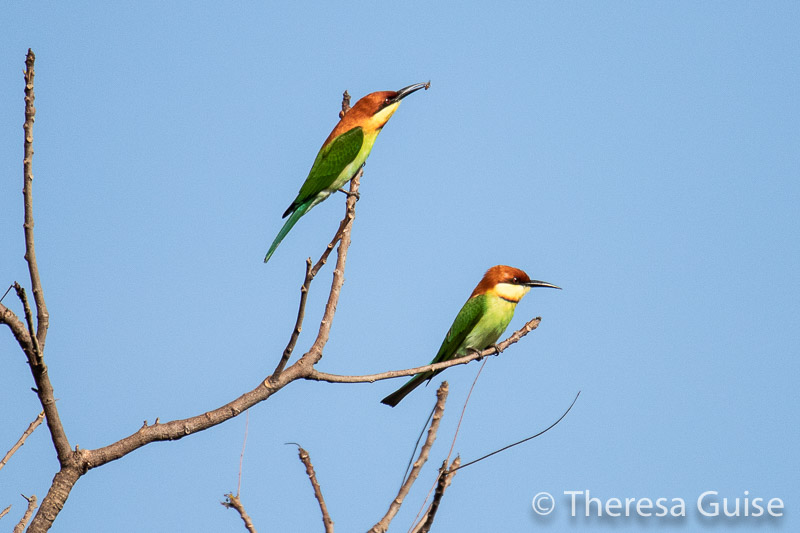
Theresa Guise: I recommend that you be physically prepared for a very demanding trip. It takes a lot out of you, and you have to be physically fit. I just had foot surgery two months before. I wasn't as strong in the water as I might have been otherwise. Practice your free diving skills. I would definitely extend the trip after the whales to land photo excursion to take advantage of the birds and other land animal imaging. Finally, you should think about how you could streamline your kit for underwater photography to make it as light and easy as possible. I had a heavy rig. I went with my Nauticam wide angle correction port and that’s a heavy piece of gear.
Robert Bailey: Wow, now that's a lump a glass to haul around freediving.
Theresa Guise: It's okay once you're in the water. But holding it on the side of the boat was hard, while it’s bumping and slamming. You kneel on the side of the boat holding the camera ready to dive, waiting for them to scream: ‘GO!’ then there’s this heavy thing bouncing up and down, up and down, and it’s difficult to stabilize without any padding on the boat. We didn’t use strobes as it was forbidden. A small point and shoot or Go-Pro camera is nice to have so you can put it underwater without getting off of the boat. A lot of people did this. In fact, sometimes we just shot blindly from the side of the boat. This came in handy shooting massive schools of things like the pilot whales. Make sure you bring a lot of sun protection. You need long sleeves and all of your skin should be covered actually because the sun is so strong there.
Robert Bailey: From the bruises you showed us pictures of I would probably say that you guys should have been wearing some kind of armour. Hehe.
Robert Bailey: Peter anything to add to that?
Peter de Maagt: I’d suggest that covering your arms and legs is a good idea. It is very difficult to get a really thin Lycra for men these days. Not a shortie, perhaps a thin wetsuit.
Robert Bailey: I would probably just wear a 3 mm wetsuit to be honest and keep it on with a small weight belt if possible.
Theresa Guise: No, we weren't allowed to wear weights. I would have worn a wet suit, but Alex said I was going to be too hot. Our naturalist wore a thin wetsuit and I was jealous of him because I got cold.
Robert Bailey: I often just wear a semi-dry in the tropics. You do you get criticised for being a wimp and all that, but I do see people shivering in the tropics at times.
Peter de Maagt: Yeah, I even wear a hood.
Robert Bailey: Any additional thoughts or comments guys that you would like to add to our conversation?
Peter de Maagt: Yeah, maybe one thing to add is ensuring that your operator has an official permit from the government. With a biologist on board they decide if you're going to go in or not depending on whether the animals are looking relaxed. I'm sure many non-official operators couldn’t care less about the animals.
Robert Bailey: Oh.
Peter de Maagt: The operators need to act in a manner that’s sustainable. The people we did the tour with think about the animals first, and their boats are less crowded.
Peter de Maagt: I have to give them credit in Sri Lanka. They really have a sustainable way of managing the whale tours.
Theresa Guise: Yeah, and it's really nice because there are not there only a few of you in the boat, and we hardly ever saw the other boats. We were so spread out.
Robert Bailey: Well, thank you very much for your time. Both of you, it's greatly appreciated.
RECOMMENDED ARTICLES
SUPPORT THE UNDERWATER PHOTOGRAPHY GUIDE:
The Best Service & Prices on u/w Photo Gear
 Visit Bluewater Photo & Video for all your underwater photography and video gear. Click, or call the team at (310) 633-5052 for expert advice!
Visit Bluewater Photo & Video for all your underwater photography and video gear. Click, or call the team at (310) 633-5052 for expert advice!
The Best Pricing, Service & Expert Advice to Book your Dive Trips
 Bluewater Travel is your full-service scuba travel agency. Let our expert advisers plan and book your next dive vacation. Run by divers, for divers.
Bluewater Travel is your full-service scuba travel agency. Let our expert advisers plan and book your next dive vacation. Run by divers, for divers.




